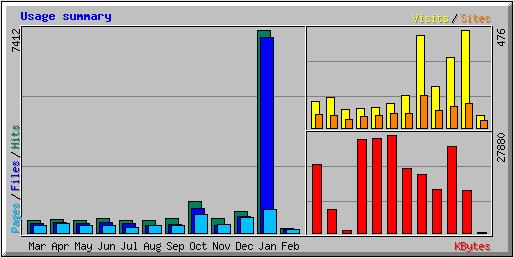One of the many things we give out to our Basic and Business customers is Webalizer, one of the most widely used and popular server side statistic tools you can use. Some people are not sure about one thing when using it. What is the difference between hits and visitors? Are they the same, are they different?
What do “Hits” mean?
Hits would be any request to the server which is logged. This could be both human, as in visitors or other computers, such as search engine spiders or bots. The request can be for anything. It could be for HTML pages, graphics, audio files and more.
What are “Visits” then?
Well if “Hits” are times the files are accessed by man or machine, then visits are when a request is made to the server from a given IP address. Now where it gets a little confusing is Webalizer calculates the time spent by that IP address on the site, page or graphic. If the time difference is larger than the configured “visit timeout” time (or has never visited before) they are considered a new visitor.
So in conclusion you could consider hits to be all the times anything accesses your web site and visits is the Webalizer’s best attempt at figuring out how many of those hits are real people looking at your web site. In comparison with tools like Google Analytics, Webalizer might report higher numbers. This is because it can see all the traffic coming in while off-site tools can only gather statistics on the pages they have special tracking codes on. Which is better? That is up for the end user to decide.
Main Headings
Hits represent the total number of requests made to the server during the given time period (month, day, hour etc..).
Files represent the total number of hits (requests) that actually resulted in something being sent back to the user. Not all hits will send data, such as 404-Not Found requests and requests for pages that are already in the browsers cache.
Tip: By looking at the difference between hits and files, you can get a rough indication of repeat visitors, as the greater the difference between the two, the more people are requesting pages they already have cached (have viewed already).
Sites is the number of unique IP addresses/hostnames that made requests to the server. Care should be taken when using this metric for anything other than that. Many users can appear to come from a single site, and they can also appear to come from many ip addresses so it should be used simply as a rough guage as to the number of visitors to your server.
Visits occur when some remote site makes a request for a page on your server for the first time. As long as the same site keeps making requests within a given timeout period, they will all be considered part of the same Visit. If the site makes a request to your server, and the length of time since the last request is greater than the specified timeout period (default is 30 minutes), a new Visit is started and counted, and the sequence repeats. Since only pages will trigger a visit, remotes sites that link to graphic and other non- page URLs will not be counted in the visit totals, reducing the number of false visits.
Pages are those URLs that would be considered the actual page being requested, and not all of the individual items that make it up (such as graphics and audio clips). Some people call this metric page views or page impressions, and defaults to any URL that has an extension of .htm, .html or .cgi.
A KByte (KB) is 1024 bytes (1 Kilobyte). Used to show the amount of data that was transfered between the server and the remote machine, based on the data found in the server log.
Common Definitions
A Site is a remote machine that makes requests to your server, and is based on the remote machines IP Address/Hostname.
URL – Uniform Resource Locator. All requests made to a web server need to request something. A URL is that something, and represents an object somewhere on your server, that is accessable to the remote user, or results in an error (ie: 404 – Not found). URLs can be of any type (HTML, Audio, Graphics, etc…).
Referrers are those URLs that lead a user to your site or caused the browser to request something from your server. The vast majority of requests are made from your own URLs, since most HTML pages contain links to other objects such as graphics files. If one of your HTML pages contains links to 10 graphic images, then each request for the HTML page will produce 10 more hits with the referrer specified as the URL of your own HTML page.
Search Strings are obtained from examining the referrer string and looking for known patterns from various search engines. The search engines and the patterns to look for can be specified by the user within a configuration file. The default will catch most of the major ones.
Note: Only available if that information is contained in the server logs.
User Agents are a fancy name for browsers. Netscape, Opera, Konqueror, etc.. are all User Agents, and each reports itself in a unique way to your server. Keep in mind however, that many browsers allow the user to change it’s reported name, so you might see some obvious fake names in the listing.
Note: Only available if that information is contained in the server logs.
Entry/Exit pages are those pages that were the first requested in a visit (Entry), and the last requested (Exit). These pages are calculated using the Visits logic above. When a visit is first triggered, the requested page is counted as an Entry page, and whatever the last requested URL was, is counted as an Exit page.
Countries are determined based on the top level domain of the requesting site. This is somewhat questionable however, as there is no longer strong enforcement of domains as there was in the past. A .COM domain may reside in the US, or somewhere else. An .IL domain may actually be in Isreal, however it may also be located in the US or elsewhere. The most common domains seen are .COM (US Commercial), .NET (Network), .ORG (Non-profit Organization) and .EDU (Educational). A large percentage may also be shown as Unresolved/Unknown, as a fairly large percentage of dialup and other customer access points do not resolve to a name and are left as an IP address.
Response Codes are defined as part of the HTTP/1.1 protocol (RFC 2068; See Chapter 10). These codes are generated by the web server and indicate the completion status of each request made to it.

